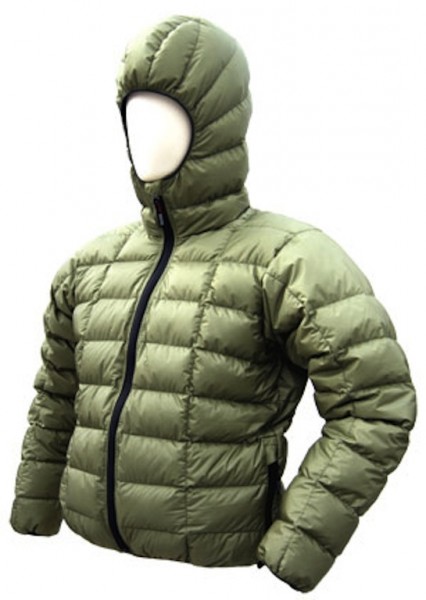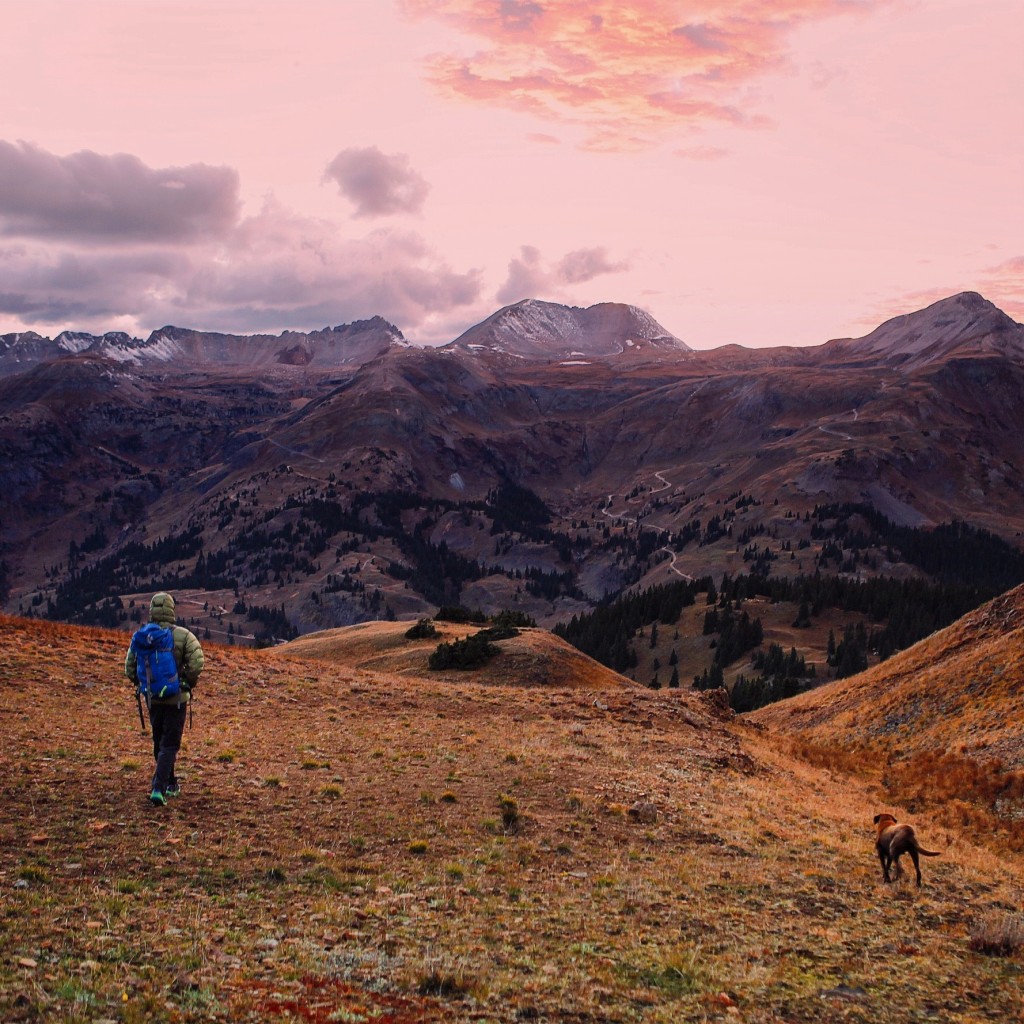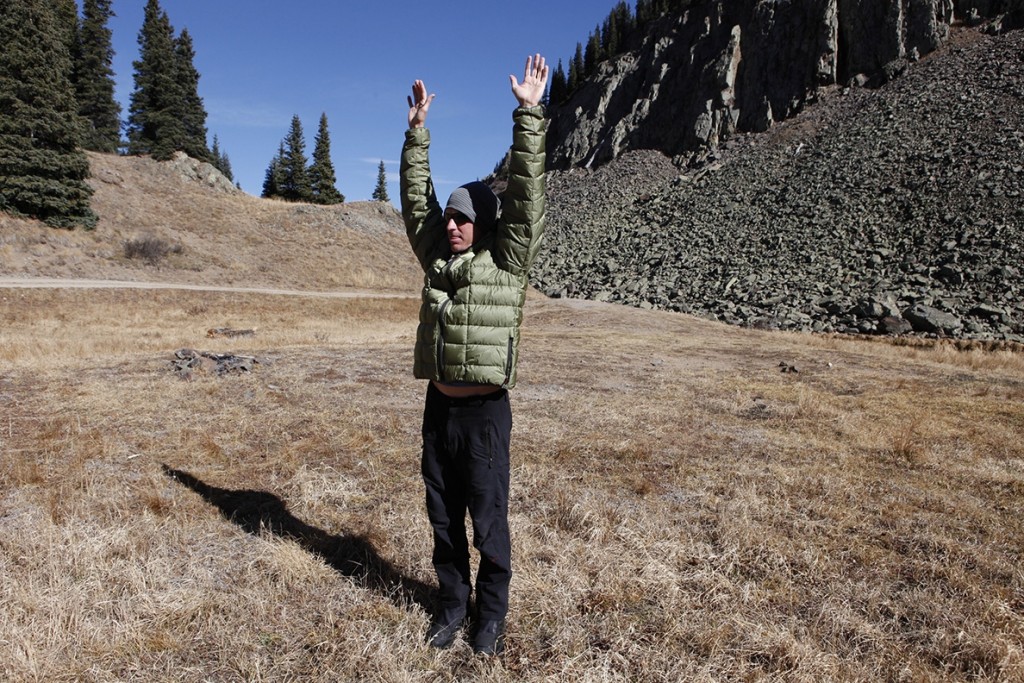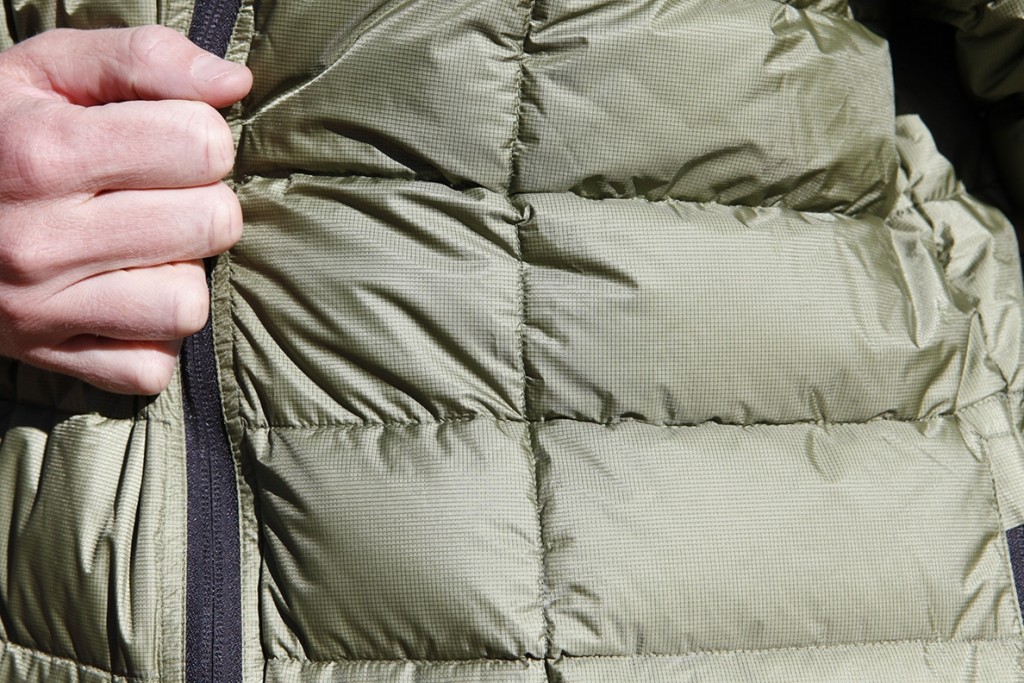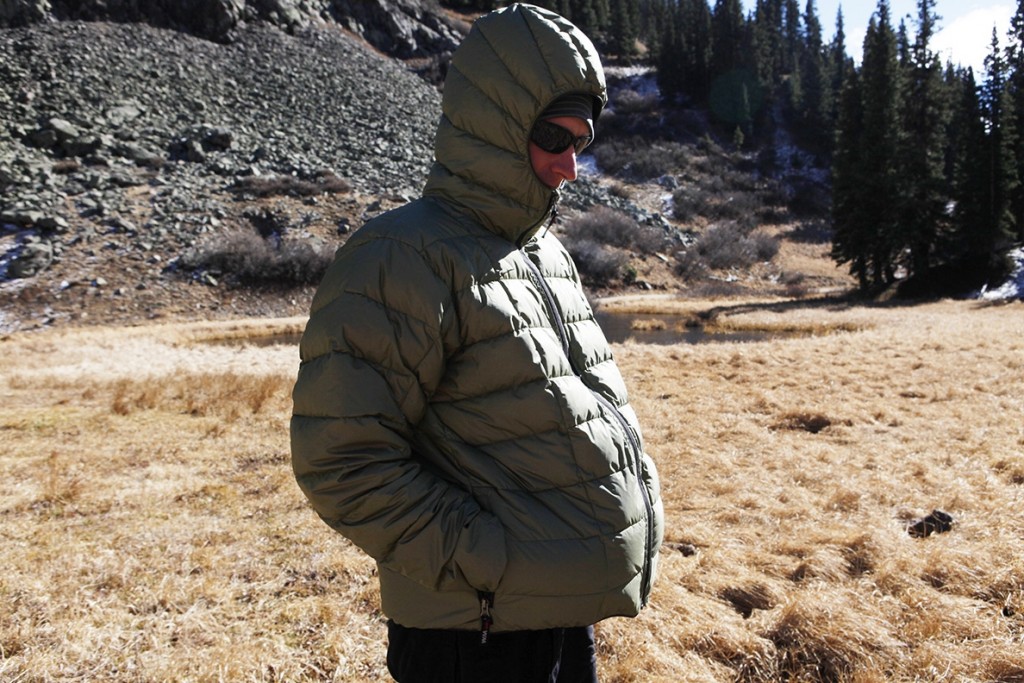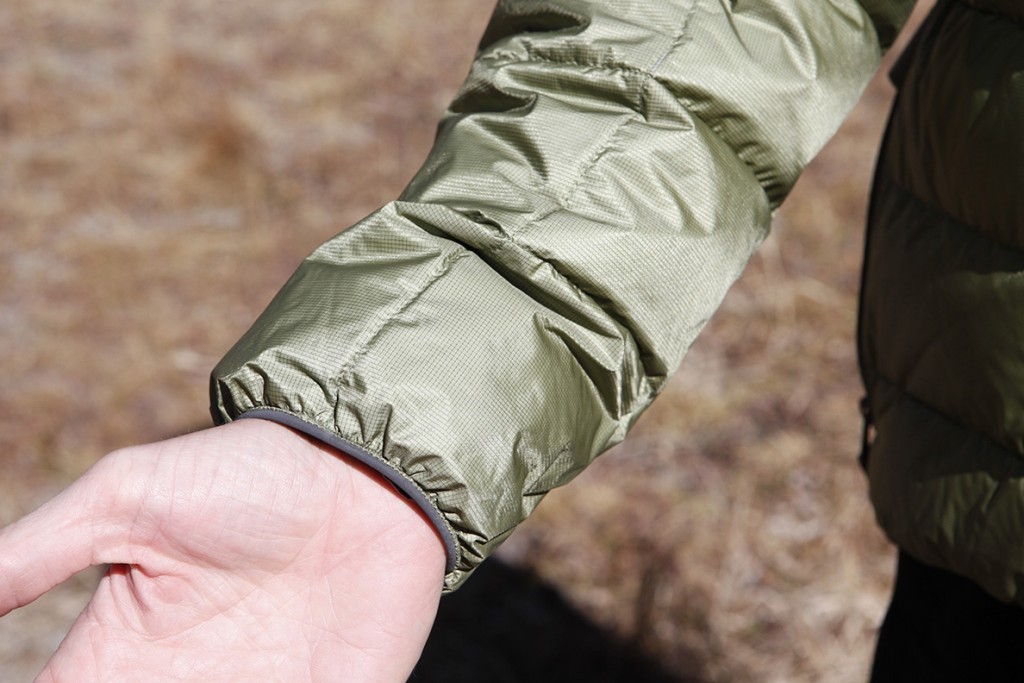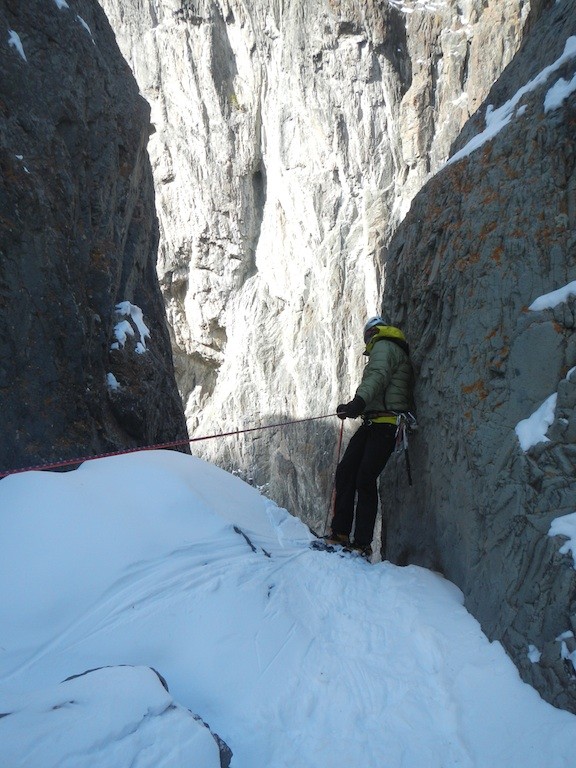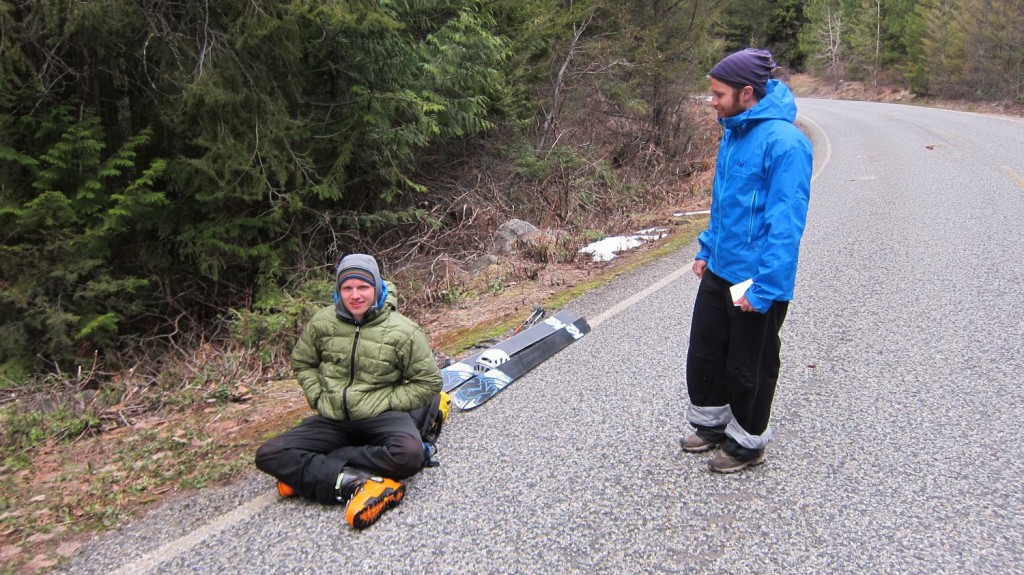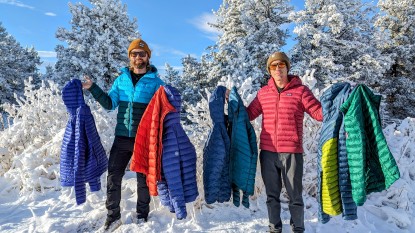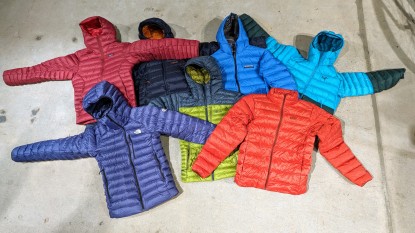Western Mountaineering Flash XR Review
Our Verdict
Our Analysis and Test Results
The Proloft XR laminated fabric used on the outside of the Flash XR is without doubt one of the most water resistant that we have tested on a down jacket. This feature, combined with the very high quality 850+ fill-power down used to stuff the horizontal sewn-through baffles are the two noteworthy elements of this jacket worth praising. While it weighs about as much as the Canada Goose Hybridge Lite Hoody, it includes virtually none of the awesome and innovative features of that jacket. In fact, with the exception of two hand pockets, this jacket has no features at all.
No internal pockets, no chest pockets, no pull cords for the hood or the waist, and no way to stuff it into a pocket or separate stuff sack for greater compression. For us, by far the most egregious fault was the incredibly bad fit. With no disrespect intended, we would describe the fit of this jacket as being shaped like an eight-month pregnant woman, except that it isn't long enough at the waist to cover, well, the waist. The errors in fit affected the performance of this jacket, not to mention grading metrics like warmth and style.
Performance Comparison
Warmth
The Flash XR features quilted sewn-through baffles filled with 850+ fill-power down. This is the highest quality down of any jacket in our review, meaning that it will give the most loft, and therefore trap heat the best, for the least weight of insulation. It also has down-backed hand pockets, meaning the inside of the pocket is not a simple piece of nylon separating your body from the pockets, but rather they are insulated with down on all sides. It is also worth pointing out that the small vertical baffle that backs the zipper is also filled with down, showing that Western Mountaineering cares about the small details that will keep you warm.
That said, our men's size large fit us perhaps poorer than any other jacket we have ever worn. We would need to put on about 60 pounds, all in the belly, in order to call this a reasonable fit. The effect was that there was a huge amount of dead air space within the jacket to warm up, and worse, the elastic lining around the waist didn't come close to sealing off the bottom of the jacket, allowing warm air to escape, and more annoyingly lots of cold air to blow up inside. It was also the shortest jacket we tested, not even covering up our waist. The REI Co-op Down Jacket also suffered from a lack of tightening capability around the waist, but we found the effect worse on this jacket. Instead of being one of the warmest jackets in the review, it ended up getting six points, a merely average rating.
Weight
Even while sporting the heavier, more water resistant Proloft XR fabric, the Flash XR weighed a low 12.5 ounces, a shade lighter than the Canada Goose Hybridge Lite Hoody. Opting for the standard face fabric will drop the weight about an ounce and make the jacket a touch more compressible at the expense of water repellency. Western Mountaineering has kept the weight down on the Flash XR by using very high quality down to maximize the warmth-weight ratio, and by eliminating virtually all features found on other jackets, ones both superfluous and also highly desirable. Its low weight is one of its strengths, and we awarded it seven points for this metric.
Water Resistance
We tested the water resistance of the outer layer of all the down jackets in this review by spreading them out in a gentle fall rainstorm in Colorado, so we could see side-by-side how they compared to each other. After about 15 minutes of exposure to the liquid moisture in the air, we found that the Flash XR was the least wet of any jacket in the test, tied with the Patagonia Down Sweater Hoody. While the Down Sweater Hoody relied on a superior DWR repellant on essentially nylon face fabric, the Proloft XR face fabric of the Flash XR was superior due to its lamination. Long story short, while it isn't filled with hydrophobic down like some of the other jackets in this review, it does have the most water resistant face fabric of any we tested, a very positive characteristic if you live or play in wet climates. Eight out of 10.
Compressibility
The Flash XR received a three out of 10 for compressibility, the lowest score in this test. While its 850 fill-power down should be capable of compressing very tightly, the jacket came with no built-in stuff sack in a pocket, like nearly every other jacket we tried, or even an included external stuff sack, like the Arc'teryx Thorium SV. The best we could do was roll it up inside its own hood, and the resulting football shaped pillow was of course bigger than every other stuffed jacket. While you can still stuff it loose in your pack around all your other stuff, we are just disappointed that such an expensive product could seemingly overlook simple features that all of the other products include, and which would cost it nothing in added weight.
Style
The word that best sums up the style and cut of this jacket is: unflattering. While the grid-patterned Proloft XR fabric looks cool, and the colors are earthy and natural, the shape of this jacket is like a balloon. It is not uniformly spacious, like some of the other jackets that are designed to be outer layers, it is literally round shaped in the torso. Another issue is that the waist is very high. In our most recent head tester's case, it didn't even cover his waist. Not only is this not functional, it just looks terrible. If you are considering style as part of your choice for a down jacket, we encourage you to instead investigate the Patagonia Down Sweater Hoody or the Outdoor Research Transcendent Hoody. For some reason we still awarded it five out of 10 points, but this was the lowest scoring jacket in this metric.
Features
Simplicity is the word to be used here. The Flash XR has elastic tubing around the front of the hood and the waist. The only adjustment point is on the back of the hood — a small fabric cinch allowing for tightening of the hood front to back. We find the hood to be well fitting in terms of warmth, coming down almost to the eyebrow, and fitting over or under a helmet. That said, the cinch on the back of the hood for adjustment is very chintzy - not only does it not work well and has a low range of adjustability, it is impossible to manipulate with gloves on, and is very cheap-feeling.
The most unique feature on the Flash is the down-filled pockets. When you put your hands into the pockets on the Flash, there is down on both sides. Although this sounds simple, no other jacket in this review has this feature. It greatly increases comfort and hand-warming performance when using the pockets. We love that Western Mountaineering builds their pockets like this as even many heavier parkas from other manufacturers neglect this comfort.
As we have already mentioned, we desperately wish that the waist had an adjustment cord, as that would go a long way toward trapping heat and not allowing cold air to blow up from the bottom. We also wish it had chest pockets, an internal stash pocket or two, and a way to stuff itself into a compressible ball. Whereas the simplicity of the features on the Mountain Hardwear Ghost Whisperer Hooded seemed intentional and well considered, the simplicity of the Flash XR feels more like the designers simply forgot to add what was needed. Four out of 10.
Best Applications
With a specialized water resistant shell, minimal features, and a good warmth-to-weight ratio, the Flash XR is ideally suited as a technical down jacket, especially in wetter climates. Of course, that is taking for granted that you are happy with the fit. We implore you to be sure you have a way to return this jacket should it not suit your body type.
Value
This jacket retails for a relatively expensive $440. While we understand that high quality water resistant materials and the best down available don't come cheap, we also expect a perfectly fine-tuned, innovative design for that sort of money. Both the Arc'teryx Thorium SV and the Canada Goose Hybridge Lite Hoody deliver on this promise and do a decent job of justifying their price tags. The Flash XR does not. For $150 to $200 less, we think this jacket's flaws would be acceptable, but as one of the more expensive options we have tested, we don't think it provides good value for the investment.
Conclusion
The Western Mountaineering Flash XR has high potential based upon its use of highly water resistant Proloft XR laminated face fabric and very high loft 850 fill-power down. Unfortunately, it squanders that potential by being shaped like a balloon, and failing to include many features that are downright necessary for a jacket of this style, and not at all optional. It comes at a steep price, and compared to other super warm jackets that we tested like the Marmot Guide Down Hoody, which cost a fraction of dough, we can't really recommend this one to a friend.
Other Versions and Accessories
Flash Hooded Down Jacket
- Cost: $375
- Weight: 10.25 ounces
- Essentially the same jacket with a lighter weight ripstop nylon face fabric instead of the water resistant Proloft XR


